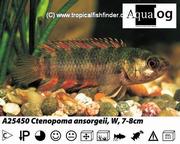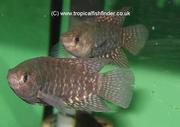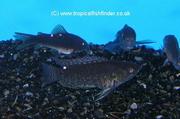Article categories:
Select a category below to view articles on each subject.
Search
Enter your keyword/s below to search :

Fish delivered straight to your door from Wildwoods
Hundreds of Species available today…
TFF Mailing List
Join the TFF mailing list today and we will email you with latest offers, news items and more.
Microctenopoma - Small African Climbing Perch for the Community Tank
The smaller climbing perches of the genus Microctenopoma are among the more overlooked oddball fishes in the hobby. For the most part they are hardy, adaptable fish well suited to community tanks alongside species of similar size. Only one or two species would be classed as delicate or difficult to keep, but even with these it's more about providing the right food and water chemistry than anything more challenging. This makes Microctenopoma particularly fine choices for moderately experienced aquarists looking for something different to the usual gouramis and cichlids.
Taxonomy
There are thirteen species of Microctenopoma currently recognised by ichthyologists. Until the mid 1990s all were included in the genus Ctenopoma, but in 1995 the ichthyologist S M Norris identified two distinct branches in the family tree of African climbing perches, one of which was Ctenopoma in the strictest sense, and the other one Microctenopoma. The differences between them are subtle and only apparent when specimens are examined under a microscope, including features such as the precise shape of the scales.
Contrary to what might be supposed by the use of the term "micro-" in their name, Microctenopoma does not include all the smaller species while the bigger species were left in Ctenopoma; some Ctenopoma are in fact quite small fish. Rather, the name refers to the comparative size of certain structures on the scales, the ones on Microctenopoma being smaller.
Distribution and habitat
Microctenopoma are strictly African in distribution, and mostly from the central, largely rainforest area around the Congo River basin. Some are also found in the West African region as well. Microctenopoma congicum is one of the species with the widest distribution and has been reported from Chad, Nigeria, Republic of the Congo and the Democratic Republic of the Congo.
Like other climbing perches, Microctenopoma favour thickly vegetated, slow-moving to still water habitats such as sluggish rivers, lakes, streams and ponds. Using their labyrinth organ to breathe air, they can tolerate lower oxygen concentrations than most other types of fish. But with that said, Microctenopoma are not especially characteristic of swamps and other oxygen-poor habitats, and they aren't able to move across land from one pool to another. In this sense they are clearly different to the Asian Climbing Perches (Anabas spp.) and some of the more robust African Climbing Perches (Ctenopoma spp.).
Maintenance
In very general terms Microctenopoma can be maintained like any other gourami of similar size. The biggest difference between Microctenopoma and typical gouramis is that they're wild-caught rather than farmed fish, so it may take some time for them to adapt to life in mixed species set-ups. In itself feeding isn't normally a problem as they happily take frozen foods like bloodworms and brine shrimps, but because Microctenopoma prefer shady tanks and are often most active during the twilight hours of dawn and dusk, getting them to feed properly in a busy community tank may be tricky. Indeed, some species, particularly Microctenopoma ansorgii, may never be really comfortable unless kept on their own or alongside small, peaceful dither fish species such as rasboras.
Because Microctenopoma are relatively small fish, they are eminently suitable for relatively small aquaria. A pair of Microctenopoma ansorgii could be maintained without problems in a 70-litre aquarium, while a small group of Microctenopoma fasciolatum could be added to a community tank 100 litres in size or larger. Although the males are territorial they are not normally aggressive, but as ever with labyrinth fish it's a good idea not to keep too many males together, and if you are keeping more than one male, it's best to keep at least one female per male, and ideally more than that.
The ideal Microctenopoma aquarium will be of appropriate size, provided with gentle filtration, maintained at around 24-28 degrees C, and thickly planted around the sides and back of the tank. Floating plants would be a plus, too. On the whole Microctenopoma don't do much digging, so any sort of substrate could be used, though a dark substrate would minimise their tendency to "fade" their colours when exposed to the sort of strong aquarium lighting needed to grow plants.
Compatibility
With a few exceptions, Microctenopoma are shy fish ill-suited to rough-and-tumble community tanks. They should certainly never be kept with aggressive cichlids, and even dwarf cichlids can cause problems for them. They do best if allowed to be "top dog" in their community tank, and tankmates should be chosen from groups unlikely to harass or threaten them. Small catfish work particularly well, and among African species, the smaller Synodontis like the Dwarf Synodontis would be obvious candidates for use alongside Microctenopoma. There are of course any number of South American species that could work, particularly Corydoras and the smaller loricariids such as Ancistrus and Peckoltia spp.
Dither fish are very useful additions to the Microctenopoma aquarium. Dither fish are peaceful, schooling species that swim close to the surface of the water. In the wild these are the fish that spot above-the-waterline predators like herons first, and if that happens they usually dart away from open water and hide among the plants. Fish that live near the bottom, like Microctenopoma, watch these dither fish carefully; if the dither fish are swimming about happily, they feel more confident and swim about in the open as well. But if there are no dither fish swimming about, the bottom-dwelling fish feel afraid, and stay hidden among the plants.
By adding dither fish to the aquarium, Microctenopoma can be encourage to swim about in the open where the aquarist can watch them. Dither fish should not be so large the Microctenopoma view them as a threat; Silver Dollars or Tinfoil Barbs for example won't work. Similarly, aggressive or nippy dither fish won't help much either, so Tiger Barbs and Serpae Tetras won't work either. Depending on your water chemistry, the best dither fish will be things like minnows, danios and livebearers. These fish are bold and confident, and crucially important is the fact they swim about near the top of the tank, where the Microctenopoma can see them.
Breeding
Microctenopoma are infrequently spawned though the general pattern seems similar to that of other labyrinth fish. Given the right environmental conditions and suitable conditioning foods, males build bubblenests and then encourage the females to spawn. Once that happens the males guard the eggs, driving the females away. The males look after the eggs until they hatch, which takes a little over a day, and then guards the fry until they are free swimming.
Microctenopoma generally require soft water to spawn and moderate to high temperatures; aim for 2-12 degrees dH, pH 6.5-7.5, 25-28 degrees C. Like all bubblenest-building species, they prefer still or slow-moving water (air-powered filtration is recommended) and lots of floating vegetation (floating Indian fern is ideal). The fry are very small and require suitably small live foods once they're ready to feed; infusoria work best for the first 3-4 days, after which brine shrimp nauplii can be used.
Species roster
Microctenopoma ansorgii
Microctenopoma ansorgii is the best-known Microctenopoma and one of the most regularly sold. It gets to a maximum length of about 7 cm, but small youngsters are the ones most likely to be seen on sale. These rarely show much of the vivid colouration for which the species is celebrated. In breeding condition the males especially are spectacular, with vivid black bands running vertically across the flanks and fins, and on the dorsal and anal fins these bands are interspersed with cherry red bands as well. Some reddish colouration may be present on the body as well, but otherwise the body tends to become rather pale. The overall effect is wonderful, but to see these fish at their best you really need to provide them with a densely-planted aquarium with plenty of shade. Soft, slightly acidic water is also helpful. Sexing can be tricky, but generally males have longer dorsal and anal fin tips and their colours are more strongly developed.
Microctenopoma fasciolatum
Sometimes called the Banded Ctenopoma, Microctenopoma fasciolatum is a charming but variable species that gets to about 8 cm in length. The most desirable form is steel blue in colour with pale vertical bands; a more less brown coloured form is also available that has most of its blue colouration concentrated on its fins. In terms of care, all the forms seem the same, and they're generally recognised as hardy, easy to keep fish well suited to community systems with tankmates that aren't going to harass them but aren't so small or delicate that they won't get along with these sometimes boisterous climbing perch. Sexing is not too difficult with this species, the males generally having longer dorsal and anal fin tips; they may also exhibit more blue colouration on the body and fins than the females.
Microctenopoma congicum
Essentially identical in terms of care to Microctenopoma fasciolatum, this species looks very similar but is more reddish-brown in colour with light, slightly metallic speckles on its body. Like Microctenopoma fasciolatum, the males have longer fins than the females, and they also tend to be more strongly coloured. Though less showy than the blue variety of Microctenopoma fasciolatum, this species is attractive nonetheless, and a worthwhile aquarium fish. Microctenopoma congicum is sometimes sold as the Congo Ctenopoma, but it may also be mixed up in batches of Microctenopoma fasciolatum and sold as the Banded Ctenopoma.
Microctenopoma nanum
This species is usually sold as the Dwarf Ctenopoma. It's a nice, robust little fish with a gentle personality and no particular demands. It isn't fussy about water chemistry provided extremes are avoided, and does well in community tanks alongside tankmates of similar size. It is basically light brown in colour with dark vertical bands, but in breeding condition males turn dark blue with only a trace of the vertical bands remaining visible.
Other fish articles:
Other fish articles you may be interested in are listed below, click an article for full details.
-
FISH ARTICLE
-
FISH ARTICLE
-
FISH ARTICLE
-
FISH ARTICLE









